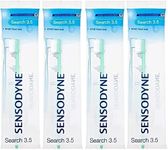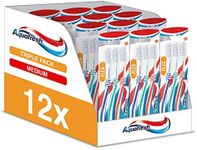Buying Guide for the Best Manual Toothbrushes
Choosing the right manual toothbrush is essential for maintaining good oral hygiene. With so many options available, it can be overwhelming to decide which one is best for you. Understanding the key specifications and how they relate to your personal needs will help you make an informed decision.Bristle TypeBristle type refers to the texture and firmness of the toothbrush bristles. This is important because it affects how effectively the toothbrush cleans your teeth and gums. Bristles can be soft, medium, or hard. Soft bristles are gentle on gums and recommended for people with sensitive teeth or gum issues. Medium bristles provide a balance between comfort and cleaning power, suitable for most people. Hard bristles are more abrasive and can be effective for removing plaque but may cause gum irritation if used too aggressively. Choose a bristle type based on your dental health and comfort preferences.
Head SizeThe head size of a toothbrush determines how easily it can reach different areas of your mouth. Smaller heads are better for accessing hard-to-reach places, such as the back molars, and are ideal for children or adults with smaller mouths. Larger heads cover more surface area and can make brushing quicker but may be harder to maneuver in tight spaces. Consider the size of your mouth and your ability to reach all areas when selecting a head size.
Handle DesignHandle design affects the comfort and control you have while brushing. Ergonomic handles with non-slip grips can make brushing easier and more comfortable, especially for people with limited dexterity or arthritis. Straight handles are simple and effective, while angled handles can help reach difficult areas. Choose a handle design that feels comfortable in your hand and allows you to brush effectively.
Bristle PatternBristle pattern refers to the arrangement of bristles on the toothbrush head. Different patterns can target specific cleaning needs, such as removing plaque, massaging gums, or cleaning between teeth. Some common patterns include flat, wavy, and multi-level. Flat bristles are uniform and provide consistent cleaning, wavy bristles can adapt to the contours of your teeth, and multi-level bristles can reach different areas more effectively. Consider your specific dental needs, such as plaque buildup or gum health, when choosing a bristle pattern.
MaterialThe material of the toothbrush can affect its durability and comfort. Most toothbrushes are made of plastic, but some may have rubber elements for added grip or comfort. There are also eco-friendly options made from bamboo or other sustainable materials. Plastic toothbrushes are widely available and durable, while bamboo toothbrushes are biodegradable and environmentally friendly. Choose a material based on your preferences for durability, comfort, and environmental impact.


















